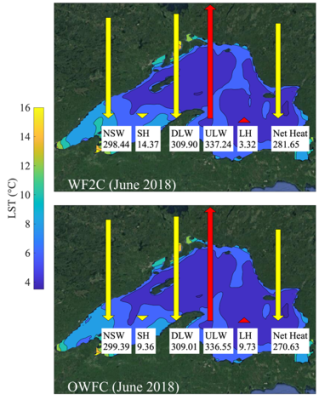Insights from Simulating Summer Warming of the Great Lakes
The climate of the Great Lakes is undergoing notable and important to study shifts. However, regional climate models have typically employed simple models to represent the Great Lakes, resulting in lake surface temperature (LST) biases and inadequate regional climate simulations. To address this issue, researchers developed WF2C, a new comprehensive regional climate modeling system for the Great Lakes region that represents the Great Lakes using a three-dimensional lake model. WF2C improved upon past one-dimensional lake model-based studies by significantly reducing the simulated LST bias. They then studied how lake-atmosphere coupling affects simulated summer LST, a critical aspect of developing a predictive understanding of the Great Lakes climate system. They found that coupled lake-atmosphere dynamics can lead to a higher simulated summer LST by modifying surface heat fluxes and influencing meteorological state variables.
The analysis of the impact of coupled lake-atmosphere dynamics on the simulated Great Lakes summer LST revealed that new processes are activated in WF2C, underscoring the importance of lake-atmosphere coupling for accurately predicting the Great Lakes thermal structure. These mechanisms are currently poorly understood and warrant more focused investigation in future studies. This study highlights the complexity of the coupled lake-atmosphere system and sheds light on the importance of process-oriented studies for improving regional climate simulations. As WF2C is unconstrained by observational data, it is positioned as a potentially robust tool for future Great Lakes climate projections.
Researchers developed and validated a fully two-way coupled modeling system, called WF2C, using the Weather Research and Forecasting model and a three-dimensional hydrodynamic and ice model based on the Finite Volume Community Ocean Model. Using WF2C, researchers also investigated the potential impacts of lake-atmosphere coupling on simulated summer LST. They evaluated the difference between WF2C and an observation-driven modeling system where the Finite Volume Community Ocean Model is replaced by observation-based LST data. The findings reveal that coupled lake-atmosphere dynamics can lead to a higher LST from June – September as there is a higher net surface heat flux entering the lake in June – July and a lower net surface heat flux entering the lake in August – September. The unstratified water in June distributes the higher incoming surface heat flux throughout the water column, leading to a minor LST increase. The stratified waters of July create a conducive thermal structure for the lake surface to warm rapidly under the higher incoming surface heat flux, maintaining a relatively higher temperature. This study provides a foundation for future work exploring WF2C’s potential to produce reliable climate projections and accurately simulate the lake-atmosphere dynamics of the Great Lakes under future climate conditions.

